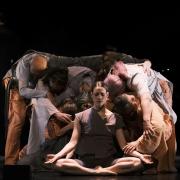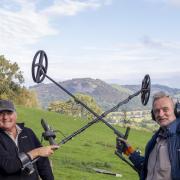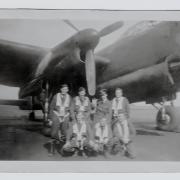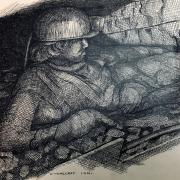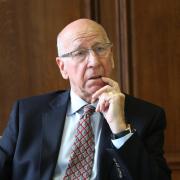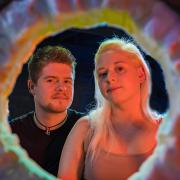Few people are around now to recall first-hand the role that our region played in World War Two. This writer’s new book has intriguing details of activities on the Wirral. WORDS BY ROBERT SHAW
The contribution of airborne radar to the winning of the Second World War, puts it up there with the achievements of the code-breakers of Bletchley Park in terms of national significance and historic importance. Action on the Wirral had a role in this.
This was especially the case when it came to defeating Hitler’s U-boats. In 1942, the U-boat packs were sinking merchant ships faster than the Allies could build them. Britain had to keep supplies from across the Atlantic flowing into Liverpool and other ports. The development of ‘ASV’ (Air to Surface Vessel) radar by British scientists was the key factor in averting a menace which could have resulted in defeat for Britain in the war.
Radar systems were invented and developed by scientists at the radar research establishment at Malvern, then further developed, tested and proven at Defford, the secret airfield built in the grounds of Croome Park, the ancestral seat of the Earls of Coventry. It has been said with truth, that the Battle of the Atlantic was won over the green fields of Worcestershire. But Worcestershire is a long way from the sea where ASV radar needed to be tested!
The Dee estuary became the place of choice for ASV testing, often with trials aircraft from Defford out-based at RAF Valley aerodrome on Anglesey. The ideal target for radar trials was the substantially intact wreck of ‘SS Nestos’, a Greek steamer which went aground on Hoyle Sands off Hoylake and was abandoned in April 1941, while trying to avoid an enemy attack. The wreck varied from being almost totally exposed at low tide, to being almost covered at high tide. This offered a range of different target profiles for radar trials.
In the autumn of 1941, aircraft from Defford experimented with bombing ‘blind’ using ‘H2S’ radar, dropping smoke bombs from 5000 feet, while a low flying Anson aircraft circled the wreck, recording the fall of the bombs.
Meanwhile, across the Wirral and on the other side of the Mersey, an extraordinary cargo was unloaded at Liverpool Docks. It was an elderly American airliner, a Boeing 247D of 1933 vintage, which had arrived as deck cargo, for use by the British in radar trials.
Why ship an old civilian airliner across the Atlantic, at the height of the U-boat menace when shipping space was at a premium, when British radar scientists would have had the choice of almost any RAF aircraft they wanted? The answer goes right to the top – to the outcome of a secret mission to Washington in 1940, after the Fall of France while the United States was still neutral, ordered by Winston Churchill and agreed by President Roosevelt. The mission was charged with handing over to the Americans, without pre-conditions, all the latest British inventions – including the atomic bomb, the jet engine and not least the magnetron, which transformed the capabilities of radar.
Taking the magnetron, the Americans with characteristic energy, set to work under the guidance of a British scientist, Dr ‘Taffy’ Bowen, and built their own radar around the British invention. The Boeing 247D came as a flying demonstrator of the resultant prototype US radar, which became the basis of the radar adopted by the night fighter squadrons of the RAF for the rest of the War and indeed into the 1950s.
‘The Boeing’, as everyone soon called the old airliner, was given the RAF serial number DZ203. The merchant ship from Hoboken, New Jersey, carrying the precious deck cargo, arrived at Liverpool Docks on July 28th 1941, and next day the Boeing was unloaded by floating crane. The aircraft was swiftly transported by road to Speke aerodrome for re-erection.
An RAF pilot, Frank Griffiths, was sent to Speke to test fly the Boeing and deliver it for tests on the American radar. Thereafter, the Boeing 247D DZ230, the only one of its kind in this country, turned out to the ideal aircraft for other radar trials. The flying career of Frank Griffiths, who went from Flight Lieutenant to Group Captain in the course of the war, was inextricably linked with that of ‘The Boeing’. Griffiths in fact was a local boy, who knew well the waters of the Dee.
He was educated at Mostyn House School, situated on the old harbour front of Parkgate, overlooking the Dee estuary. Always something of a rebel, after Frank left school, he joined his friends the local fishermen, and made a living selling his catch in Liverpool. But with war clouds gathering, he joined the RAF. He became a pilot and after service in the Far East, escaped the Japanese invasion of Singapore, to return to fly radar trials in this country. Apart from an interval of dropping supplies to the French resistance, when he was shot down, captured, escaped and made his way back to England, he remained closely involved with radar trials in ’The Boeing’ throughout the war.
In 1942, a new role was found for the Boeing, involving Griffiths, exploring the secrets of X-band wavelength radar, which offered a major leap forward in radar capability, especially for Fleet Air Arm and Costal Command aircraft seeking out U-boats and enemy aircraft. The trials with ‘The Boeing’, based at RAF Valley, used the wreck of the SS Nestos as a target, but also tested its ground-scanning radar as far afield as Chester and Warrington. During this time, so important was the work that Boeing 247D DZ203 was carrying out, it was awarded ‘Top Secret’ status. This meant it had to be under armed guard at all times while on the ground, a unique accolade for civil airliner. However, the associated stringent security requirements caused problems when in 1943, ‘The Boeing’ was out-based at Andreas on the Isle of Man for trials with the Royal Navy over the Irish Sea. But the trials were a success, it was shown that ‘X-band’, unlike other radar systems, was able to spot the Schnorkel tubes of Hitler’s ‘Super U-boats’, and another Nazi threat was averted.
In January 1945, in its ultimate achievement, after being completely rebuilt with new radar systems at Defford and with Griffiths at the controls, Boeing 247D DZ203 demonstrated the World’s First automatic orbit, approach and blind landing. ‘The Boeing’ went on for a further two years advancing the cause of automatic landing, pointing the way to the ability of airliners to operate in all weathers and darkness, which we take for granted today, before meeting its end in circumstances in which accounts vary, in the harsh winter of 1947.
Top Secret Boeing
The story of the Boeing 247D DZ203 and more on airborne radar trials around wartime Wirral and Cheshire, is told in Bob Shaw’s new book ‘Top Secret Boeing’ (ISBN 9780954704513), priced £11.95, on sale at Lingham’s Bookshop, 248 Telegraph Road, Heswall; also on Amazon and at some Waterstones branches. Bob is from Cheshire.




